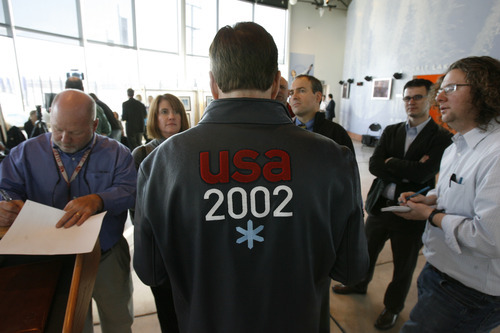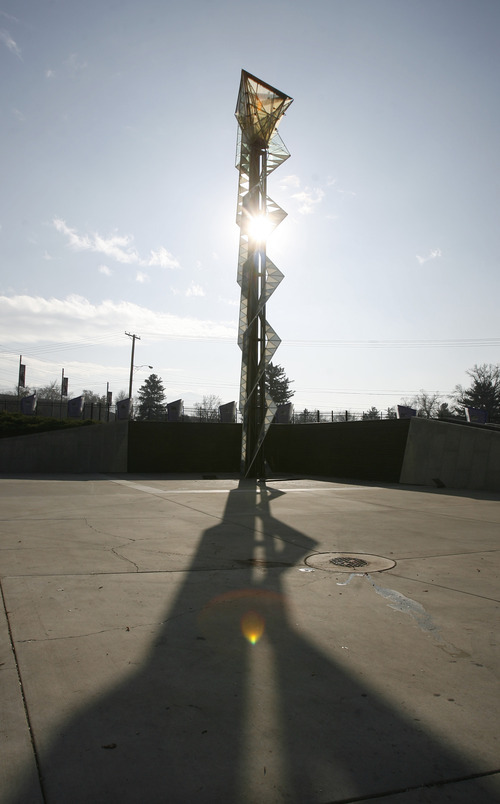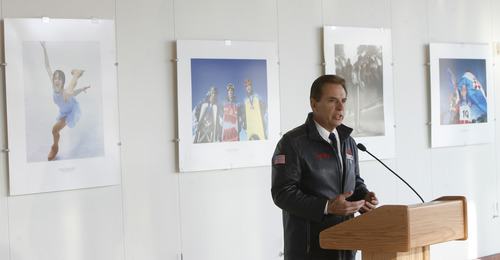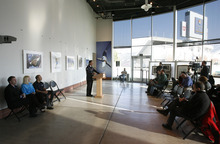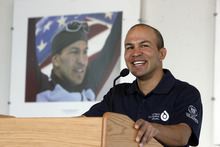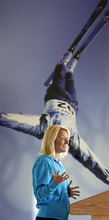This is an archived article that was published on sltrib.com in 2011, and information in the article may be outdated. It is provided only for personal research purposes and may not be reprinted.
Olympic volunteers, break out those distinctive coats you wore during Salt Lake City's Winter Games.
There's going to be a Feb. 18 reunion for you — and for everyone else who enjoyed themselves at the 2002 Olympics — at the Olympic Legacy Plaza in downtown Salt Lake City's Gateway.
Wearing a natty blue leather athlete's jacket from the Olympics he supervised as the Salt Lake Organizing Committee's No. 2 executive, Fraser Bullock announced details Wednesday of a public celebration commemorating the 10th anniversary of Utah's global coming-out party.
The event will feature a free daytime sports festival, with interactive winter-sport demonstrations, athlete appearances, photo and video exhibits, and reunions of the Games' 24,000 volunteers. That evening, a ticketed "Salt Lake 2002 Stars on Ice" show at EnergySolutions Arena will pay tribute to the stars of the Olympics and Paralympics.
Sarah Hughes, who won a gold medal in that building a decade ago, has been invited.
So has the man who ran those Games, Republican presidential nominee Mitt Romney.
Bullock is not sure yet whether Romney can make it. Dates of GOP primary events change regularly. But Bullock is certain that if Romney returns to his scene of Olympic glory in Salt Lake City, "it wouldn't hurt him in the campaign at all."
The Olympic celebration will begin Feb. 8, the date the Games began 10 years ago, with a relighting of the caldron on the south end of the University of Utah's Rice-Eccles Stadium. This will be a media event, Bullock said, timed to coincide with the evening TV news since a lack of space limits public involvement.
He also expressed hope that news organizations will keep alive the Games' "Light the Fire Within" theme throughout that period by doing stories about what happened each day a decade earlier.
There are many reasons, Bullock said, to celebrate what the Olympics did for Utah.
Individual memories. The achievements of athletes. Economic development. Worldwide recognition of how friendly Utahns were in efficiently running the Games. A $100 million profit, three-quarters of which went into an endowment that has kept Olympic facilities operational for not just elite athletes, but also for ordinary residents, including kids on their way to becoming the next generation of Olympians.
"This has become the mecca of winter sports," Bullock said, noting that 40 percent of the U.S. team at the 2010 Vancouver Olympics lived part of the year in Utah. In addition, the U.S. ski, speedskating and bobsled teams are all based here now. "This is a legacy all Utahns can be proud of."
Bullock also recalled the importance of Salt Lake City's Olympics to a world still reeling from the shock of the 9/11 terrorist attacks, just five months earlier.
As he watched the tattered U.S. flag from the Twin Towers brought into Rice-Eccles Stadium during the Opening Ceremony, with the crowd standing in "reverent attention," Bullock said "I knew this would be a healing moment for the world under the umbrella of sport."
Speedskater Derek Parra was one of eight athletes who carried the flag into the stadium. Now a youth program director at the Utah Olympic Oval in Kearns, Parra called it a defining experience in his life, inspiring him to silver- and gold-medal performances.
"Time stood still. We were all affected by it," he said. "Today, we are a better people, a better country. The Games were special not just to the city, but to the country, to the world."
Fellow silver medalist Shannon Bahrke, a moguls skier who also calls Utah home now, echoed that sentiment. "The energy in the stadium lifted me to new heights," she said. "Light the Fire Within embodied who I am."
What separates Salt Lake City's Olympics from most others is the post-Games use of facilities, said Colin Hilton, president of the newly renamed Utah Olympic Legacy Foundation, which runs the oval and the Utah Olympic Park ski jumps, bobsled/luge track and freestyle aerial pool outside of Park City.
"We built the venues for high-performance athletes," Hilton noted. "But they're often used by people of all ages, all abilities. Activity has never been greater."
The Olympic anniversary celebration is expected to cost $300,000 to $350,000, Bullock said. Most of that revenue is expected to come from ice show ticket sales and corporate donations. Salt Lake County also is providing $25,000, including $5,000 for a community activity at the Kearns oval.
Twitter: sltribmikeg —
What's planned
Feb. 8 • On the 10th anniversary of the 2002 Winter Olympics' Opening Ceremony, the caldron will be relit outside of the University of Utah's Rice-Eccles Stadium.
Feb. 18 • A free sports festival will take place from 10 a.m. to 5 p.m. at Gateway shopping center in downtown Salt Lake City, followed at 7 p.m. by a "Salt Lake 2002 Stars on Ice" show at EnergySolutions Arena.
Details are being worked out for celebrations in venue communities: Park City, Kearns, Heber City, Provo and Ogden. —
Olympic legacies
Tickets for the Feb. 18 "Stars on Ice" show will cost $30 to $125. They may be purchased on organizers' revived Olympics-era website, http://www.saltlake2002.org.
Both the International Olympic Committee and U.S. Olympic Committee have provided written approval of the anniversary bash. In fact, the USOC will have a presence there, making Salt Lake City one of four stops (New York, Los Angeles and Houston are the others) on a tour promoting the 2012 London Summer Games.
Northern Utah had four ice sheets in the mid-1990s. Now it has 16, spurring the growth of skating sports.
Photographic exhibits and videos about the 2002 Games will be on display in Union Pacific Depot's Grand Hall at The Gateway.
Any profits from the ice show will go to the Utah Olympic Legacy Foundation to build youth sport programs.



